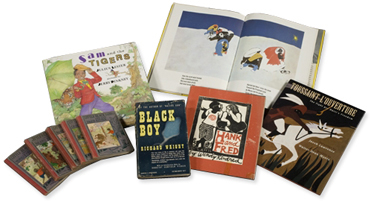Sambo’s subtext
An unsettling but enduring children’s book is the subject of a new Special Collections exhibit.
By Carrie Golus, AB’91, AM’93
Photography courtesy Special Collections Research Center

The children’s book Little Black Sambo inspires uneasy feelings with its racist imagery, but a new library collection offers a rich trove for research into the story’s evolution.
“There is very little to say about the story of Little Black Sambo,” reads the preface to the first American edition (1900), which, thanks to donors Barbara and Bill Yoffee, AB’52, I was able to hold in my hand at the Special Collections Research Center. As the preface explains, “an English lady in India, where black children abound and tigers are everyday affairs,” had written and illustrated the story for her two young daughters during a long train journey.
Of course, there is plenty to say, or at least ask, about Little Black Sambo. It’s just that talking about it can create uneasy feelings. When I told a colleague I was working on a piece about the book, I watched his eyes widen, and stay wide, as I babbled on, trying to contain the damage. “It’s actually a really important donation to Special Collections, all these different editions of Little Black Sambo.” He nodded but looked unconvinced. Great, I thought. Now he thinks I’m a racist.
What is it about Little Black Sambo that inspires such discomfort? Why is it so widely considered racist? And if it’s racist, why has it endured?
“It’s a story that children love,” says Alice Schreyer, director of Special Collections, “a classic children’s story.” In the original (if you have forgotten the details, as I had), Sambo gets a new outfit: a Red Coat, Blue Trousers, a Green Umbrella, and “a lovely little Pair of Purple Shoes with Crimson Soles and Crimson Linings,” in Helen Bannerman’s quirky capitalization. “And then wasn’t Little Black Sambo grand?”
But as he walks through the jungle, Sambo has to give away his fine clothing, piece by piece, to four tigers so they won’t eat him; he manages to persuade them to take even the seemingly useless shoes (“You could wear them on your ears.”) and the umbrella (“You could tie a knot on your tail, and carry it that way.”).
The tigers then fight over the clothes, chasing each other around a tree so quickly that they turn into melted butter. Sambo’s father scoops up the butter, his mother fries pancakes in it, and Sambo “eats a Hundred and Sixty-nine, because he was so hungry.” The End.
Or not. First, there’s the name “Sambo,” which was “already in opprobrious use in the United States,” says Schreyer. Then there are Bannerman’s odd illustrations, which seem to reflect the influence of American racist imagery. But Bannerman, who was untrained, had never been to the States. Would she have seen racist drawings somehow? Would she have seen a minstrel show?
Despite Bannerman’s primitive illustrations (like many children’s authors of the time, she was just a parent desperate to amuse her kids), Little Black Sambo, published in England in 1899, was immediately popular.
As the Yoffee collection shows, the story was adapted over and over again, with different words and pictures. “The illustrations became increasingly stereotypical and harsh,” says Schreyer. “It became incendiary.”
The most recent books in the collection take the opposite approach. Two versions, both published in 1996, attempt to sanitize the story in different ways.
The Story of Little Babaji returns to Bannerman’s original words, superfluous capitals and all. But the illustrations, by Fred Marcellino, portray Indian characters, and the “Note on the Text” points out: “The Story of Little Black Sambo...clearly takes place in India, with its tigers and ‘ghi’ (or melted butter),” so the characters have been given “authentic Indian names.”
Then there is Sam and the Tigers, written by Julius Lester and illustrated by Jerry Pinckney. As he perused more than 50 versions of Little Black Sambo, Pinckney writes in the introduction, “I struggled hard to find my own approach to right the wrongs of the original and several subsequent versions.”
In this adaptation, the little boy, Sam, lives in Sam-sam-sa-mara. The characters are African American, the clothing from the 1920s, the language slangy: “Ain’t I fine,” Sam declares.
Both The Story of Little Babaji and Sam and the Tigers are sincere and well-intentioned. Yet, for me, it’s almost as hard to look at them as it is to look at the original.
The Yoffee material includes nearly 1,000 works of children’s and African American literature drawn from the couple’s longtime passion for collecting. There is a 1945 first edition of Richard Wright’s autobiography, Black Boy, and a copy of Black Child Care by African American psychiatrists James P. Comer and Alvin F. Poussaint that highlights the 1960s-era “beautiful and black” ethos.
The works cover a broad range of topics such as race relations, health, and education, written by and for African Americans, while also reflecting the Yoffees’ interest in graphic design and illustration. A lot of the imagery can make you feel pretty uncomfortable.
Next year the collection will be available for researchers, but it hasn’t been completely processed yet. I feel like I haven’t completely processed it yet either.
Return to top
